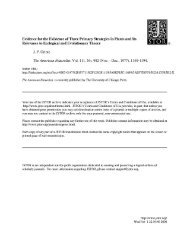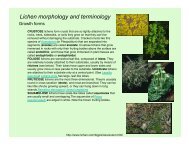Arctic Ecosystems in Russia - Alaska Geobotany Center
Arctic Ecosystems in Russia - Alaska Geobotany Center
Arctic Ecosystems in Russia - Alaska Geobotany Center
Create successful ePaper yourself
Turn your PDF publications into a flip-book with our unique Google optimized e-Paper software.
ARCTIC ECOSYSTEMS IN RUSSIA<br />
mg dm" 2<br />
Fig. 16.49. Invertebrate mass (mg, fresh weight) under moss<br />
cushions <strong>in</strong> different polar desert communities with various<br />
density of plant cover at Cape Chelyusk<strong>in</strong>, Taymyr. A, 5%<br />
cover; B, 20% cover; C, 60% cover. From Chernov et al. (1979).<br />
mosses and a decrease <strong>in</strong> production and biomass<br />
reserves <strong>in</strong> soil <strong>in</strong>vertebrates (Fig. 16.49). This<br />
testifies to an imbalance between the cover and the<br />
climatic conditions (Matveyeva and Chernov,<br />
1976; Chernov et al., 1979). Thus, the denser the<br />
cover, the worse the hydrothermal conditions <strong>in</strong><br />
the soil, which <strong>in</strong> turn negatively <strong>in</strong>fluence the<br />
activity of microorganisms (Par<strong>in</strong>k<strong>in</strong>a, 1971, 1973,<br />
1979a-c, 1986) and of soil <strong>in</strong>vertebrates (Fig.<br />
16.50) (Chernov et al., 1971, 1973; Chernov,<br />
1978b), <strong>in</strong>hibit the process of organic-matter decomposition,<br />
and thereby reduce the fertility of soil<br />
which is already very poor <strong>in</strong> nutrients. All this<br />
reduces the possibilities for growth and viability of<br />
plants and decreases their resistance to unfavorable<br />
environmental conditions. With a lowered<br />
plant activity, the cryogenic processes cause the<br />
turf to die off <strong>in</strong> patches, which lays the ground<br />
bare. This occurs even <strong>in</strong> the southern tundra<br />
subzone <strong>in</strong> communities with a dense plant cover.<br />
The process of bare-patch overgrowth parallels<br />
that of the appearance of new bare patches. Uncover<strong>in</strong>g<br />
of the ground is the result not only of the<br />
<strong>in</strong>ability of the plant cover to resist the cryogenic<br />
processes but also of erosion by w<strong>in</strong>d and snow.<br />
The dense cover on the "plakor" of the tundra<br />
zone is an unstable phenomenon. The <strong>in</strong>terruption<br />
<strong>in</strong> succession does not occur simultaneously over<br />
a large territory occupied by a given type of<br />
community. It is a local phenomenon. Thus, <strong>in</strong><br />
spite of the permanence of these processes and<br />
419<br />
their cyclicity (endogenic succession result<strong>in</strong>g <strong>in</strong> a<br />
cont<strong>in</strong>uous plant cover —> <strong>in</strong>terruption of succession<br />
—> new development from the pioneer stage<br />
on bare ground), the general pattern of the cover<br />
rema<strong>in</strong>s <strong>in</strong>variable. The apparent stability of the<br />
cover is the reason why frost-boil, spotty, and even<br />
polygonal communities <strong>in</strong> the arctic tundra subzone<br />
are sometimes called climax communities<br />
(Gorodkov, 1956; Aleksandrova, 1959, 1970). This<br />
is correct only when term<strong>in</strong>al stages <strong>in</strong> the development<br />
of the plant cover may be identified <strong>in</strong> a given<br />
climate as climax stages, not tak<strong>in</strong>g <strong>in</strong>to account<br />
such an essential feature as the state of equilibrium<br />
of productive and destructive processes. A dense<br />
plant cover can exist for a comparatively long time<br />
only <strong>in</strong> the southern tundra subzone and to some<br />
extent <strong>in</strong> the typical tundra subzone, but even there<br />
no complete balance of <strong>in</strong>come and expenditure of<br />
organic matter is observed. In the arctic tundra<br />
subzone, the disequilibrium between plant cover<br />
and the environment is so strong that cover destruction<br />
often prevails over its recovery. In the<br />
typical tundra subzone, this is manifested <strong>in</strong> a high<br />
proportion of spotty tundras <strong>in</strong> "plakor" conditions<br />
(with partial overgrowth of the ground surface).<br />
In the arctic tundra subzone, communities<br />
with dense cover are absent on "plakor", while<br />
spotty and polygonal communities <strong>in</strong> which the<br />
bare ground has not been overgrown are predom<strong>in</strong>ant.<br />
Fig. 16.50. Mass (g, fresh weight) of worms of different groups<br />
<strong>in</strong> elements of frost-boil communities with various density of<br />
plant cover <strong>in</strong> the typical tundra subzone at Tareya, Taymyr. A,<br />
patches of ground with crust of crustose lichens; B, patches<br />
be<strong>in</strong>g overgrown with small cushions of mosses and vascular<br />
plants; C, patches overgrown with cont<strong>in</strong>uous th<strong>in</strong> moss turf;<br />
D, rims with dwarf-shrubs, sedges, and mosses; E, troughs filled<br />
with mosses; 1, Nematoda; 2, Enchytraeidae; 3, Lumbricidae<br />
(Eisenia nordenskioldi). From Y.I. Chernov et al. (1971).




